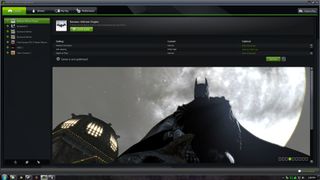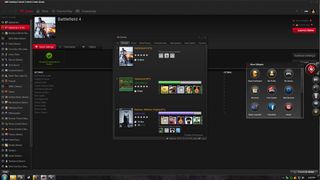The human touch
In a similar approach, Nvidia also leverages the expertise of hardcore PC gamers, except it uses real-life people in its testing labs around the world.

James Wang, GeForce Experience product manager, was happy to tell us that Nvidia does its optimization work in-house with labs in Moscow, Santa Clara, Calif. and Shenzhen, China.
Each lab employs a team of expert testers to figure out which settings are most important and contribute the greatest to the gameplay experience, all the while leaving out those that simply eat up performance.
"We figured it out pretty early that you can't just run scripts and not have anyone look at it because in the end, when you say to people [that] we recommend these settings are the best, that really requires a subjective call," Wang expounded. "For example, if anti-aliasing or texture quality is more important in a game, a computer can't tell you which one is more preferable."
To do this, Nvidia uses an optimization that tests different combinations of CPU and GPU hardware. While Nvidia doesn't test every single CPU release, Wang was quick to note that every GPU released by Nvidia is covered. Plus, the team constructs a performance index of all Nvidia's GPUs on the market today.
This drawn-up list of recommendations is fed into Nvidia's own algorithm and loaded onto a server of different PC part setups. From there the lab team takes the priority list and figures out how to turn on as many graphics settings as possible.
No perfect system
Both Nvidia and AMD have developed similar systems using two different approaches, but each has its own set of flaws. Wang specifically criticized AMD and Raptr's crowdsourced approach as a privacy risk as well as being ineffective.
Get daily insight, inspiration and deals in your inbox
Get the hottest deals available in your inbox plus news, reviews, opinion, analysis and more from the TechRadar team.
"If we just did pure data mining from the users, it's a lot of data being mined and not everyone is comfortable with that," Wang broached. "The other thing is that when you mine the common case, the average answer is not necessarily the correct answer."
These privacy issues were misconceptions that Fong addressed by explicitly saying, "all of this data is used exclusively for optimization. We don't sell any user data [belonging to] individuals or otherwise, it's just to make the optimizations better."
He elaborated that "when a lot of people think about crowd sourcing, then they think whatever is popular, but that does not really work in this particular case because popular is the lowest common denominator of default settings."

Nvidia, meanwhile, has a system that arguably cannot account for every possible PC configuration out there. Wang contended that "the dominant performance impacting parts are the GPU, CPU and of course the resolution of the monitor."
"The more important number [to gamers] - is their PC covered?" he posed. "We cover pretty much all the CPUs today and all of our GPUs, both desktop and notebook."
In the future, Wang and Fong each told us to expect more games to make it under their respective optimization trees. Currently Gaming Evolved serves 65 games with roughly seven being added every week, while GeForce Experience supports 130 games since starting with a meager 30-plus titles.
Features on the horizon
Beyond optimization Nvidia and AMD have implemented other features for the streaming and YouTube gaming communities. The Nvidia GeForce Experience app brought a built-in game capture tool called ShadowPlay, which allows gamers to record and upload their own gameplay using only their graphics card.

Gaming Evolved, on the other hand, implements an easy way for users to start streaming their games on Twitch. Nvidia also recently added Twitch integration.
Both Wang and Fong agreed that the emergence of YouTube and eSports have taken off as a huge part of the gaming community, but just like optimization, Nvidia and AMD have adopted different approaches to game capture and streaming features.
Whereas Nvidia does more work behind the scenes, AMD utilizes an overlay that goes on top of full-screen games to give gamers access to their web browser without having to Alt-Tab.
Looking towards the future, Wang teased that Nvidia's ability to stream games through its graphics cards beyond using just the Nvidia Shield.
"We haven't talked about that right now, but the core technology of streaming does not require the end point has to be a Shield," Wang said. "It is possible that you can stream to another device but we haven't announced any direction to go there."
For AMD, Fong said that Raptr wants to implement more tools into its screen overlay, but we'll hear more about this as we head into January along with more announcements at CES 2014.
Kevin Lee was a former computing reporter at TechRadar. Kevin is now the SEO Updates Editor at IGN based in New York. He handles all of the best of tech buying guides while also dipping his hand in the entertainment and games evergreen content. Kevin has over eight years of experience in the tech and games publications with previous bylines at Polygon, PC World, and more. Outside of work, Kevin is major movie buff of cult and bad films. He also regularly plays flight & space sim and racing games. IRL he's a fan of archery, axe throwing, and board games.

